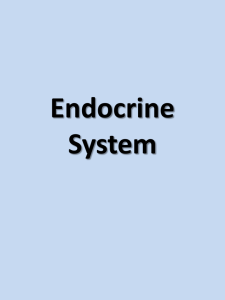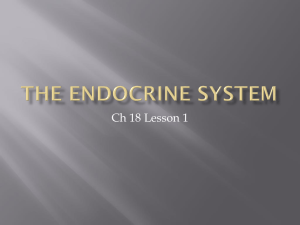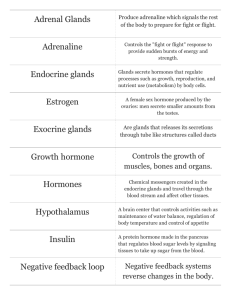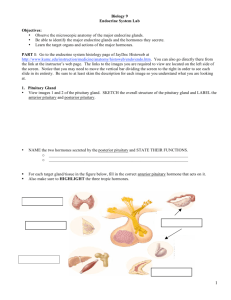the endocrine system
advertisement
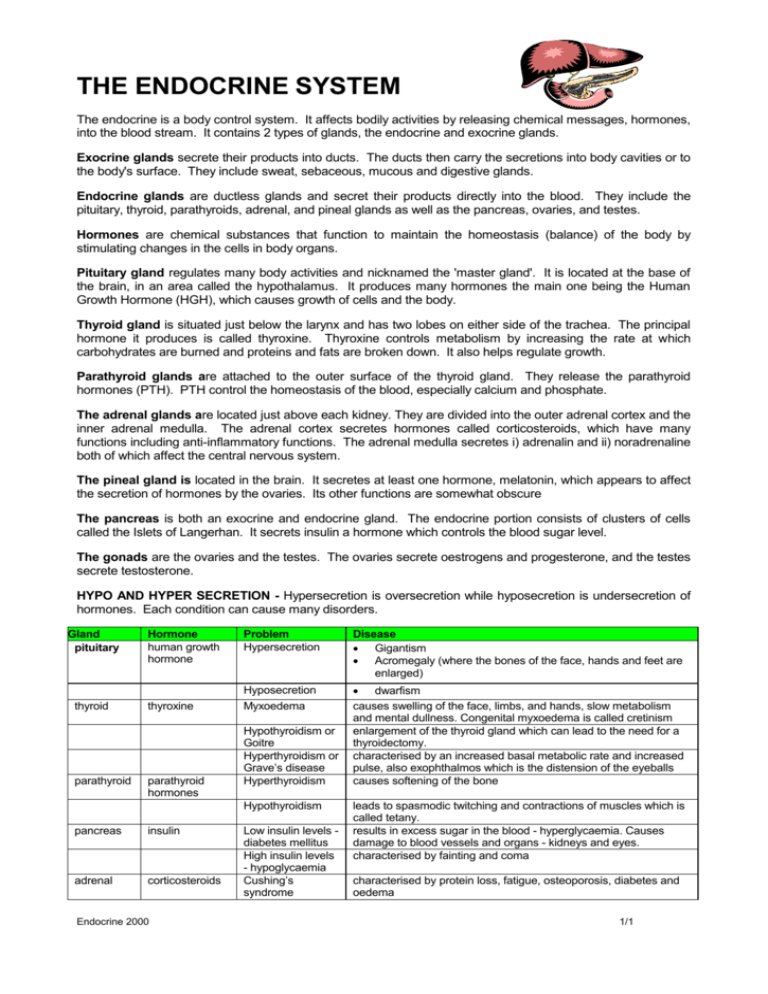
THE ENDOCRINE SYSTEM The endocrine is a body control system. It affects bodily activities by releasing chemical messages, hormones, into the blood stream. It contains 2 types of glands, the endocrine and exocrine glands. Exocrine glands secrete their products into ducts. The ducts then carry the secretions into body cavities or to the body's surface. They include sweat, sebaceous, mucous and digestive glands. Endocrine glands are ductless glands and secret their products directly into the blood. They include the pituitary, thyroid, parathyroids, adrenal, and pineal glands as well as the pancreas, ovaries, and testes. Hormones are chemical substances that function to maintain the homeostasis (balance) of the body by stimulating changes in the cells in body organs. Pituitary gland regulates many body activities and nicknamed the 'master gland'. It is located at the base of the brain, in an area called the hypothalamus. It produces many hormones the main one being the Human Growth Hormone (HGH), which causes growth of cells and the body. Thyroid gland is situated just below the larynx and has two lobes on either side of the trachea. The principal hormone it produces is called thyroxine. Thyroxine controls metabolism by increasing the rate at which carbohydrates are burned and proteins and fats are broken down. It also helps regulate growth. Parathyroid glands are attached to the outer surface of the thyroid gland. They release the parathyroid hormones (PTH). PTH control the homeostasis of the blood, especially calcium and phosphate. The adrenal glands are located just above each kidney. They are divided into the outer adrenal cortex and the inner adrenal medulla. The adrenal cortex secretes hormones called corticosteroids, which have many functions including anti-inflammatory functions. The adrenal medulla secretes i) adrenalin and ii) noradrenaline both of which affect the central nervous system. The pineal gland is located in the brain. It secretes at least one hormone, melatonin, which appears to affect the secretion of hormones by the ovaries. Its other functions are somewhat obscure The pancreas is both an exocrine and endocrine gland. The endocrine portion consists of clusters of cells called the Islets of Langerhan. It secrets insulin a hormone which controls the blood sugar level. The gonads are the ovaries and the testes. The ovaries secrete oestrogens and progesterone, and the testes secrete testosterone. HYPO AND HYPER SECRETION - Hypersecretion is oversecretion while hyposecretion is undersecretion of hormones. Each condition can cause many disorders. Gland pituitary thyroid parathyroid Hormone human growth hormone thyroxine parathyroid hormones Problem Hypersecretion Disease Gigantism Acromegaly (where the bones of the face, hands and feet are enlarged) Hyposecretion dwarfism causes swelling of the face, limbs, and hands, slow metabolism and mental dullness. Congenital myxoedema is called cretinism enlargement of the thyroid gland which can lead to the need for a thyroidectomy. characterised by an increased basal metabolic rate and increased pulse, also exophthalmos which is the distension of the eyeballs causes softening of the bone Myxoedema Hypothyroidism or Goitre Hyperthyroidism or Grave’s disease Hyperthyroidism Hypothyroidism pancreas insulin adrenal corticosteroids Endocrine 2000 Low insulin levels diabetes mellitus High insulin levels - hypoglycaemia Cushing’s syndrome leads to spasmodic twitching and contractions of muscles which is called tetany. results in excess sugar in the blood - hyperglycaemia. Causes damage to blood vessels and organs - kidneys and eyes. characterised by fainting and coma characterised by protein loss, fatigue, osteoporosis, diabetes and oedema 1/1 Endocrine 2000 1/1




